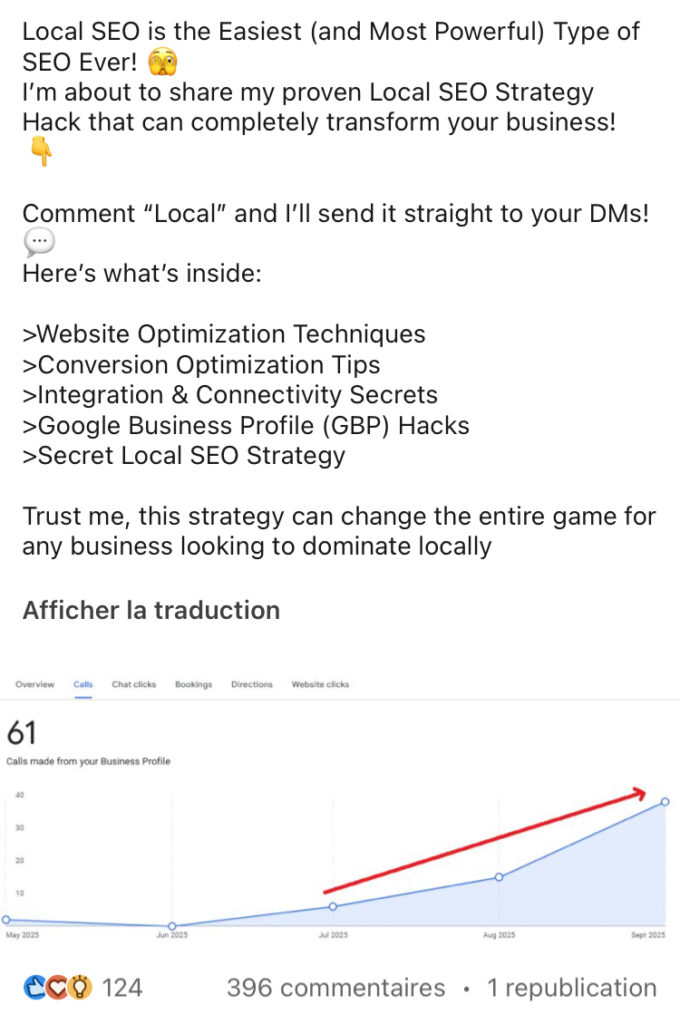Local SEO : How it should be done
Local SEO has been way oversimplified 🙄. Largely because it’s trying to appeal to burned-out small business owners who barely have time to breathe, let alone master another marketing channel.

No, Local SEO isn’t « easy ». In 2026, the strategy of creating one page per service + city is bound to fail in 95% of cases. I know this firsthand : I’ve already hit that wall hard, mostly because I leaned too heavily on popular SEO « best practices. »
Dozens of projects and hundreds of hours spent reading patents and Google Leaks forced me to completely change my method.
It’s probably not sexy for SEO nerds since it requires everything they typically avoid: an actual business, real customers, genuine local presence and real legitimacy.
But I had no choice, because I kept running into the same hard truths.
Truth #1: You won’t rank in cities where you don’t actually exist
It’s becoming increasingly obvious in Google search results: plenty of local business websites crush it in SEO despite having awful websites and poor seo optimization.
Their only real strength? They’re genuinely present in the cities they mention.
In 2024, SEO specialists Stéphane Madaleno and Adrian Delamarre dug into this exact question: How does Google get so good at finding real businesses and services?
Their study’s conclusion: Google My Business profiles (and the page/domain they link to) could have major influence on websites’s ranking in local results.
While I don’t think it’s Google’s only local ranking factor (we’ll dive into that later with Google Leaks insights), it seems pretty obvious that Google’s ingeniors can rely on that signal. To even exist on Google My Business, you have to jump through hoops to prove your business is legit and increasingly, Google is doing manual verification checks.
Google has all the tools it needs to know who’s actually operating on the ground. They don’t need your 3,000 words landing pages or your faked structured data.
Truth #2: Mass-producing « service + city » pages gets you nowhere
Because every landing page today needs to be backed by real traffic from users actually geolocated in the target city to look legitimate.
In the Google Leaks, we discovered something called the « QualityCopiaFireflySiteSignal » system, specifically designed to fight what Google now calls « scaled content abuse »:
1. Evaluation happens at the entire site level: The module name ends with « SiteSignal » which tells us Google’s assessment isn’t just page-by-page, it’s looking at your whole site.
2. Google monitors publication velocity: The system tracks how many new URLs are discovered per 30-day period (numOfUrlsByPeriods). A sudden massive spike in new pages is a classic red flag for mass content production. (The word « Copia » (Latin for abundance) in the module name makes that pretty clear.)
3. Quality beats quantity : The system doesn’t just count total pages. It compares that against the number of articles rated as high-quality (numOfArticles8). If you’re pumping out thousands of new pages but barely any hit that quality bar, Google knows the mass-produced content is low-value garbage.
4. User engagement is a key metric: Google uses click signals to measure user satisfaction. The system differentiates between dailyClicks (total daily clicks) and dailyGoodClicks (clicks where users actually found the page useful). Mass-produced pages might rack up clicks, but if the content is useless, users bounce right back to Google. That kills your dailyGoodClicks ratio and that’s a powerful mathematical signal of failure.

Even if your landing page is genuinely high-quality (because you’re skilled enough to do better mass automation and content spinning than anyone) you’re still missing the user signals from people actually on the ground.
Click location matters: if 50% of clicks to a page come from Lyon, then that page is localized to Lyon. We’re talking page-level, not site-level. And we’re talking total visits, not just visits from Google.
So a « plumber Manchester » page that gets zero traffic (or only traffic from your London clients) will never be relevant for Manchester.
This is backed by the CountryGeoLocation system and its clickRadius50Percent parameter.

Truth #3: Being closest doesn’t cut it, you need to be the most popular and most trustworthy
The patent SCORING LOCAL SEARCH RESULTS BASED ON LOCATION PROMINENCE back in 2011 already explained that when Google ranks websites or GMB listings, it creates « expanded zones » around the user’s location or search query, then compares multiple businesses within that zone.
The Local Prominence Score is determined by combining at least two of these factors (or additional ones):
1. Authoritative Document Score: For example, a restaurant’s homepage rates as more authoritative than a review of that restaurant.
2. Total number of documents referencing the business.
3. Highest score among documents referencing the business: This can be based on the link-based score of documents mentioning the business.
4. Total number of documents containing reviews of the business.
5. Total number of information documents mentioning the business (NAP): These are documents providing key info (address, phone, hours, credit card acceptance, etc.) from sources like Dine.com, Citysearch, or Zagat.com.
Optional factors can also include review score numerics, language used in reviews, user logs from interactions, business financials (annual revenue, employee count), or years in business. These get weighted and combined to generate the final score.
Sure, this patent is now 15+ years old and Google’s definitely refined the system since then. But it shows one of the core algorithmic foundations Google uses to recommend the best local businesses.
From experience, I’d say proximity to the user is still the #1 ranking factor for Google My Business listings. But how much it matters depends on the business type. Proximity is crucial for hairdressers (you’re not crossing town for a haircut) but way less important for solar panel installers.
Truth #4 : Think outside your website
For some professions (like plumbing) the brutal reality is this: you’re not going to outrank the big directories with your own website. More and more those kind of websites own page one on Google search results with no position left for corporate’s websites.
Your only move is to take what’s left. Stop obsessing over your site’s visibility and start infiltrating the directories that Google is already rewarding. Your main target should be the « Places sites » carousel (that horizontal slider of directories you see under the ads or maps).

Get your business listed there but also on the directories that are ranking with blue links. Be present everywhere, because being present only on your own site is no longer enough.
My Method
This is just a proposal, not some absolute truth. I’m here for the discussion and debate.
- Claim and optimize your Google Business profile (category, hours, photos, complete description).
- Ensure NAP consistency (name, address, phone) everywhere online. Pay special attention to old directory listings, make sure your info is up to date.
- Build local backlinks through chambers of commerce, associations, and partnerships.
- Generate and manage customer reviews regularly (and actually respond to them).
- Create service + city landing pages, but only if you can drive relevant local traffic to them via Ads or Social Media.
- Publish local content (guides, events, case studies).
- Actively engage on your Google Business profile (posts, Q&A, photos).
- Create local citations in quality directories.
- Add Local Business structured data to your local landing pages.
- Check all the directories ranking for your business keywords and make sure your company is listed there. A lead gained, even through an intermediary, is still a win.
- Embed a Google Map on your local landing pages showing your business location. Search Pilot verified how important this is in an A/B test : https://www.searchpilot.com/resources/case-studies/local-seo-embedded-map-component
- Get your employees, partners, or customers to activate the Google Maps route through your GMB listing to drive actual traffic.
- Show up in the real world and seize every opportunity (trade shows, conferences, local markets) to ask for online visibility through links, mentions, or dedicated articles about your business. Your teams should make this reflexive: « We’re happy to pay for a booth at your event, can we get a link from your official site back to ours? »
- Don’t sleep on other review platforms like Trustpilot. They’re less critical than Google reviews, but you still need to consistently earn good ratings there.
- Organize directories by city, not by service. The « propagationDepthFromParent » algorithm proves it : pages inherit the location of their parent pages.

Local SEO isn’t broken : your approach is. Stop chasing the exceptions, stop building pages in the dark hoping for rankings, and start building a real business people actually want to find. Google will reward legitimacy every single time.

Ian Sorin is an SEO consultant at Empirik in Lyon, France, specializing in local SEO projects. He studies search engine patents, conducts personal experiments, and analyzes research papers to understand how algorithms truly work—combining hands-on experience with deep algorithmic knowledge.







